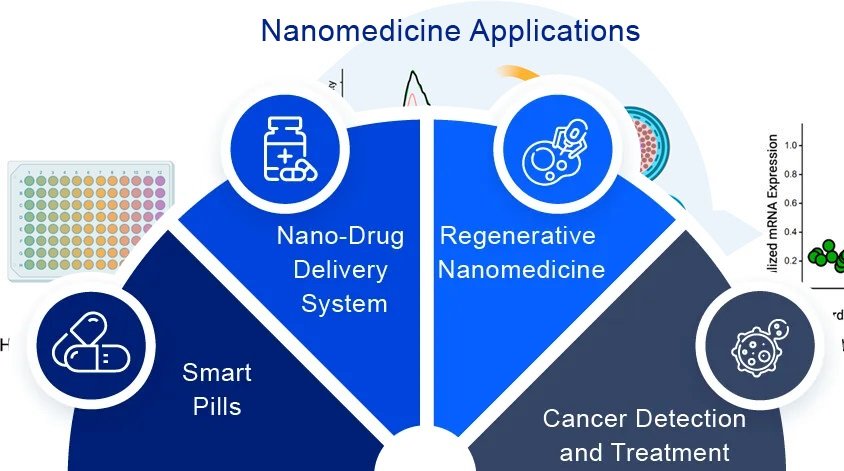In the realm of modern healthcare, the integration of nanotechnology into medicine has given rise to a revolutionary field known as nanomedicine. This article explores the definition, research endeavors, and diverse applications of nanomedicine, shedding light on its benefits, historical origins, and pivotal advancements in the field of healthcare.
Definition of Nanomedicine
Nanomedicine can be defined as the application of nanotechnology for the diagnosis, treatment, and prevention of diseases. It involves the design, fabrication, and utilization of nanoscale materials and devices to target specific cells, tissues, or organs within the body. By harnessing the unique properties of nanoparticles, such as their small size, large surface area-to-volume ratio, and tunable surface chemistry, nanomedicine offers promising solutions for addressing various medical challenges with unprecedented precision and efficacy.
Advantages of Nanomedicine
One of the key advantages of nanomedicine lies in its ability to enable targeted drug delivery. Nanoparticles can be engineered to deliver therapeutic agents directly to diseased cells or tissues, minimizing off-target effects and maximizing therapeutic efficacy. This targeted approach reduces the required drug dosage, leading to reduced side effects and improved patient compliance.
Furthermore, nanomedicine facilitates the development of personalized therapies tailored to individual genetic profiles, optimizing treatment outcomes and minimizing adverse reactions. By combining diagnostic and therapeutic functionalities into a single platform, nanomedicine enables real-time monitoring of disease progression and response to treatment, paving the way for more effective and patient-centric healthcare interventions.
Applications of Nanomedicine
The applications of nanomedicine span across various fields of medicine, ranging from cancer therapy and infectious disease management to regenerative medicine and personalized healthcare. In cancer therapy, nanoparticle-based drug delivery systems have revolutionized treatment strategies by enhancing the selectivity and efficacy of chemotherapy drugs while minimizing systemic toxicity.
Moreover, nanomedicine holds promise for combating infectious diseases through the development of targeted antimicrobial agents and vaccines. Nanoparticle-based vaccines offer improved stability, prolonged shelf life, and enhanced immunogenicity, thereby overcoming many of the limitations associated with traditional vaccine formulations.
In regenerative medicine, nanotechnology enables the fabrication of biomimetic scaffolds and tissue-engineered constructs for promoting tissue regeneration and repair. These nanostructured materials mimic the native extracellular matrix, providing a conducive environment for cell growth, proliferation, and differentiation.
History of Nanomedicine
The concept of nanomedicine traces back to the early 20th century, with the pioneering work of physicist Richard Feynman, who first proposed the idea of manipulating matter at the atomic and molecular scale. However, it wasn’t until the late 20th century that significant advancements in nanotechnology paved the way for the emergence of nanomedicine as a distinct field of research.
In 1999, the term “nanomedicine” was coined by Eric Drexler in his book “Engines of Creation: The Coming Era of Nanotechnology,” where he envisioned the use of nanoscale robots, or “nanobots,” for medical applications such as drug delivery and tissue repair. Since then, nanomedicine has rapidly evolved, with researchers worldwide exploring the potential of nanotechnology to revolutionize healthcare.
Who Invented Nanomedicine?
While nanomedicine is a multidisciplinary field encompassing contributions from various scientific disciplines, several researchers have made significant contributions to its development. Among them, Robert Langer, a renowned bioengineer, is often credited for his pioneering work in the design and fabrication of nanoparticle-based drug delivery systems. Who invented nanomedicine is a question often associated with Langer’s name, given his influential role in shaping the field.
Langer’s groundbreaking research laid the foundation for many of the nanomedicine technologies in use today, including the development of biodegradable polymer nanoparticles for controlled drug release. His contributions have earned him numerous awards and accolades, solidifying his status as a key figure in the field of nanomedicine.
Benefits of Nanomedicine
The benefits of nanomedicine are manifold, with the potential to transform the landscape of healthcare by offering more effective, targeted, and personalized treatment options. Some of the key benefits include:
- Enhanced Targeting: Nanoparticles can be designed to selectively target diseased cells or tissues, minimizing off-target effects and improving therapeutic outcomes.
- Reduced Side Effects: By delivering drugs directly to the site of action, nanomedicine reduces systemic exposure and mitigates adverse reactions, leading to improved patient safety and tolerability.
- Improved Diagnostics: Nanotechnology enables the development of highly sensitive and specific diagnostic tools for early detection and accurate characterization of diseases, facilitating timely intervention and improved prognosis.
- Personalized Medicine: Nanomedicine allows for the development of personalized therapies tailored to individual patient characteristics, such as genetic makeup, disease stage, and treatment response, optimizing treatment outcomes and minimizing adverse reactions.
Future Directions and Challenges
While the potential of nanomedicine is vast, several challenges and considerations must be addressed to realize its full benefits. These include:
- Safety Concerns: The biocompatibility and long-term safety of nanomaterials need to be thoroughly evaluated to ensure their clinical applicability and minimize potential toxicity risks.
- Regulatory Hurdles: The regulatory approval process for nanomedicine products can be complex and time-consuming, requiring robust preclinical and clinical validation to demonstrate safety and efficacy.
- Scalability and Cost: The scalability and cost-effectiveness of nanomedicine manufacturing processes need to be optimized to facilitate widespread adoption and accessibility of these advanced therapies.
- Ethical and Societal Implications: As with any emerging technology, nanomedicine raises ethical and societal concerns regarding equity, access, and privacy, necessitating thoughtful consideration and engagement with stakeholders.
Conclusion
In conclusion, nanomedicine holds tremendous promise for revolutionizing healthcare by offering innovative solutions for diagnosis, treatment, and prevention of diseases. With its unique capabilities in targeted drug delivery, personalized medicine, and regenerative therapy, nanomedicine has the potential to address many of the longstanding challenges in medicine and improve patient outcomes. As research in this field continues to advance, the future of healthcare looks increasingly bright, with nanomedicine poised to play a pivotal role in shaping the healthcare landscape for years to come.
Read more: The Rising Trend of Nursing Crop Tops: A Professional and Stylish Choice for Nurses
